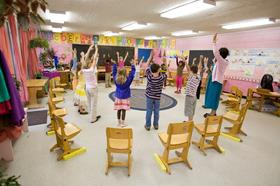Rolling Admissions
When applying to private schools, you will encounter two kinds of admissions: regular admissions or admissions with a fixed deadline and rolling admissions.
- Regular admissions or admissions with fixed deadlines are self-explanatory.
- The school will publish a specific date by which applications must be submitted.
- Rolling admissions are a little different and more flexible.
Canva generated this picture of a parent pondering admissions deadlines.

What is rolling admissions?
Rolling admissions refers to a school's practice of accepting applications until all their available seats are filled. The school will send an answer to your application within a couple of weeks, as opposed to waiting until a fixed deadline.
How does rolling admissions work?
Let's assume that the school begins accepting applications for the following school year on September 1.
- You could submit your completed application on September 2 and expect to have a decision back from the school within a time frame from two weeks to a month.
- At a school with a fixed deadline for admissions, you could submit your application on September 2 but not hear whether your child had been accepted until sometime in March, assuming the fairly common January 31 deadline.
- Many schools with rolling admissions have a priority deadline.
- You should submit your application before that deadline.
- Once all the places are filled, applications from candidates who would otherwise have been accepted will go on a waitlist.
Professor Allen Grove explains the various kinds of admissions in great detail. This is a longish but in-depth video that is well worth bookmarking for later viewing.
Which schools use rolling admissions?
Many private schools use rolling admissions.
- You can find out about a school's admissions policies on its website.
- Look for an admissions tab.
- Because private schools are unique, each has its own admissions schedules and protocols.
- Always ask what those schedules and protocols are.
- Do not assume that what one school does is the same as another.
What are the advantages of rolling admissions?
Rolling admissions gives you some flexibility in the admissions process.
- It also removes the pressure of having to meet a fixed deadline.
- This flexibility allows you to arrange school visits, testing, and all the other admissions details according to your scheduling requirements.
The other advantage of rolling admissions is that you will know whether or not your child has been accepted.
- Let's say that you applied as soon as the rolling admissions window opened.
- You should have a decision within two to six weeks.
- That still leaves time to apply to another school or schools before the January 31 admissions deadline, which many schools have in place.
This video offers another explanation of rolling admissions. While it discusses college admissions, the concept is the same for private school admissions.
What are the disadvantages of rolling admissions?
The most significant disadvantage of rolling admissions is that it can lull us parents into thinking that they have more time to apply than they actually have.
- Applying to any private school is a process.
- You have to stay organized.
Work your checklists and stay on top of all the other deadlines besides the application deadline.
- Registering for standardized testing must be done by a specific date.
- You will need to request transcripts and teacher recommendations.
- Those are essential components of most private school admissions applications.
- Stay on top of them even when schools have rolling admissions.
How does rolling admissions differ from other kinds of admissions?
Schools with rolling admissions fill available places during their rolling admissions window.
- Schools that do not have rolling admissions fill their places one time by basing their admissions decisions on completed applications received by their stated deadline, which is typically January 31.
- Acceptance letters will be mailed in mid-March.
- You will have to accept or refuse the place offered, usually within thirty days.
How long after I submit my application will we receive a decision?
Each school operates according to its own admissions rules and protocols. So I cannot give you any hard and fast answers.
- Anywhere from two weeks to two months seems to be the norm.
- The other factor is the grade level to which you are applying.
In some boarding schools, places in grades 11 and 12 will be minimal, while there will be less demand for grades 9 and 10.
- Ask the school. The admissions staff will be happy to answer those questions.
- Or ask your educational consultant. She will know the admissions history at specific schools or can find out more about it for you.
What could hold up a decision on your application?
Completing your child's admissions folder could be delayed by teacher recommendations, transcripts, test results, and any other items the school has as part of its admissions requirements.
- Use our checklists to organize choosing a school for your child.
- There are many details, dates, and deadlines to keep track of.
How soon will I have to respond to the acceptance letter?
Once the school sends you an acceptance letter, you will be given a specific date by which you must accept the place or turn it down.
Who should look at a school that has rolling admissions?
Everybody should look at schools that have rolling admissions.
- Rolling admissions does not indicate that a school is having trouble filling places.
- Schools with rolling admissions are doing the same thing that colleges and universities have done with their admissions for many years.
- They are doing all they can to make the admissions process more friendly and accommodating to our schedules.
When is the best time to apply to a school with rolling admissions?
The short answer is as soon as you can.
- Once all the places are filled, accepted applicants will be put on a waiting list.
- So it makes sense to apply as soon as you can.
- Shoot for an October-November time frame.
- That will also more than likely get you into the financial aid pool while money remains, assuming that you need final aid.
Are rolling admissions open-ended?
Not exactly. Schools that use rolling admissions usually keep their admissions open until they have filled their classes.
- After that goal has been reached, the schools will continue receiving applications.
- The understanding is that any applicants they would like to accept will be added to the waitlist.
How do rolling admissions compare with fixed-district admissions?
Both rolling admissions and regular admissions require a complete candidate folder before they can make a decision.
In other words, if your child's admissions folder is missing one or more required items such as test scores, teacher evaluations, etc., her admissions folder will sit in the pending pile until it is complete.
- The other point of comparison is that very few highly selective private schools use rolling admissions.
- Schools with rolling admissions offer your child a second chance if she is rejected at other schools.
Conclusion
Rolling admissions offer a flexible and accommodating approach to the private school application process. By allowing applications to be reviewed as they are received, families can enjoy quicker decision times and more scheduling flexibility. However, it's crucial to stay organized and apply early to avoid waitlists. This approach can be particularly beneficial for families seeking a second chance after being rejected by other schools or needing to adjust their application timeline.
Questions? Contact us on Facebook, Instagram, and YouTube. @privateschoolschoolreview
#RollingAdmissions #PrivateSchools #AdmissionsProcess #Flexibility #Enrollment #Opportunities #Education #StudentAdmissions #Deadline #FamilyConsiderations












